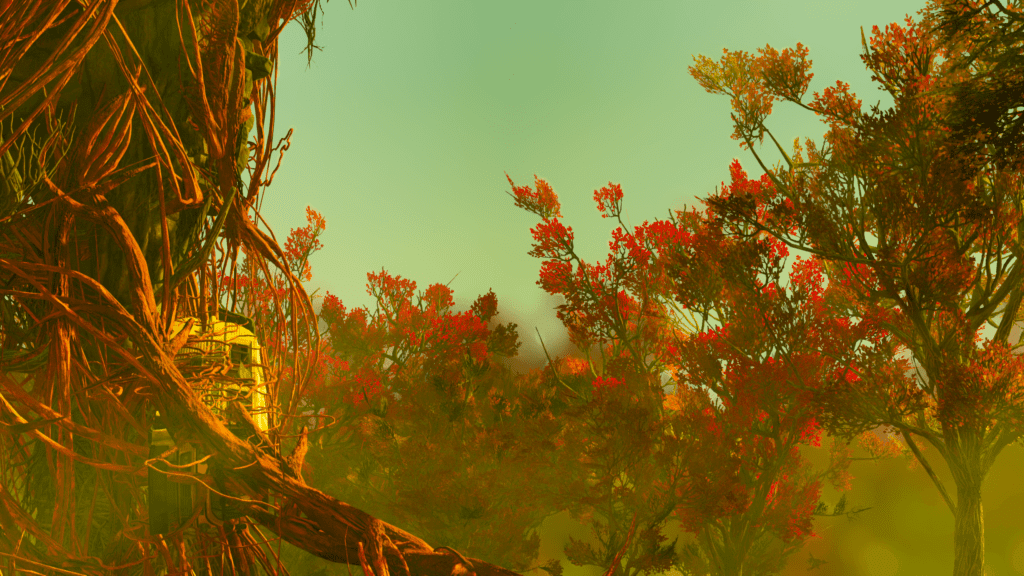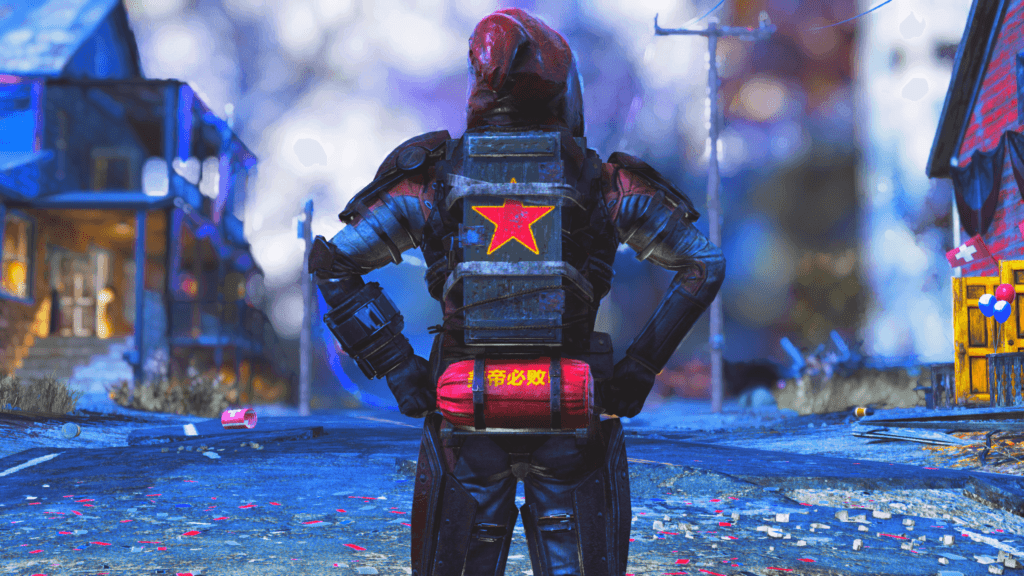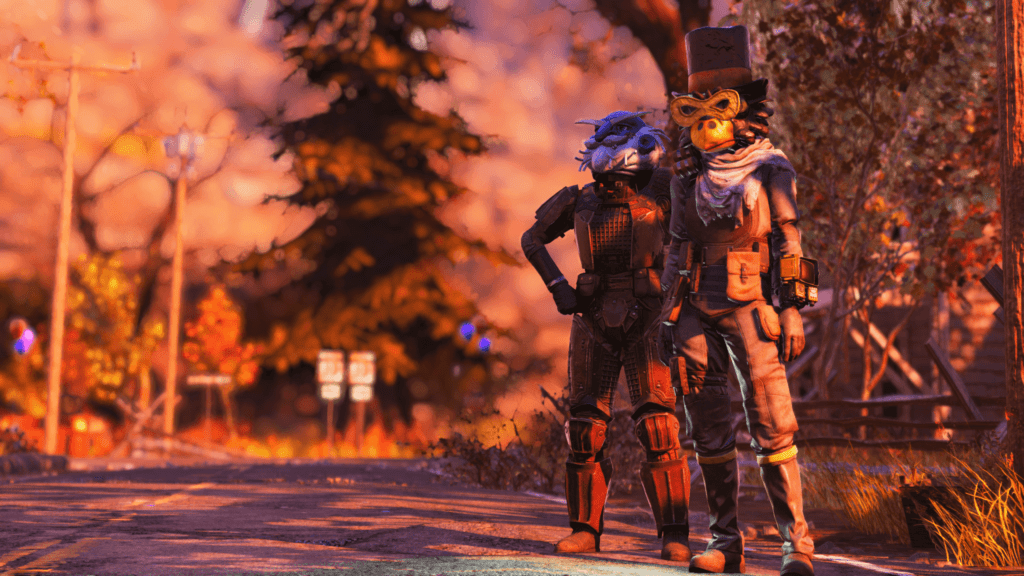There’s a deep sickness running through the heart of the Appalachian wilderness. In Fallout 76, Bethesda’s latest foray into the colourfully post-apocalyptic, an already ailing West Virginia becomes the breeding ground for a contagion born of a pre-war bioweapon. As the infected settle in alongside the irradiated, their deathly symbiosis serves as a catalyst for the eradication of the region’s last enduring survivors. By the time that the dwellers of Vault 111 are ready to emerge from their protective shelter, they do so into a world where the only remaining human voices are their own. The dangers of the road ahead are steeped in silence.
In October of 2102, ‘Reclamation Day’ commences, promising the vault’s newly liberated inhabitants a stake in the future of Appalachia. In the context of the game’s story, reclamation is the great irony upon which nuclear bombardment takes precedence over societal reformation. But in terms of the game’s multiplayer focus, it is a deceit that ultimately serves to undermine its purpose. Together with a group of friends watching your back, Fallout 76 promises a survivalist experience adorned with the familiar trappings of Pip-Boys and Stimpacks, where creative construction meets unrepentant hoarding in a cooperative setting. When the last human settlers decorate the landscape as mere corpses, when lore inconsistencies dictate a perplexing narrative and when quest direction devolves into the aimlessly unimaginative, Fallout 76 becomes complicit in the rejection of its own principals. And with nothing left to reclaim but fistfuls of caps, its world of iron and fire loses the semblance of mysticism that traditional Fallout games so effortlessly evoke.
For every quest in Fallout 76 that seems built to make the most of its multiplayer ethos, there are a dozen or so more that offer very little when it comes to story progression or world development. Within the bounds of the main narrative, successive quests serve only to volley you between locked doors and terminals, all so that you may uncover a scrap of paper or a log entry that allows the process to continue. If you’re lucky, a challenging enemy encounter may present itself along the way, but the lack of creativity in mission design is the easiest way that the world around you loses its lustre, and any desire to discover is quickly eroded. In side-missions however exist a few notable exceptions to the monotony. One task required myself and my co-op partner to run an obstacle course in a set time, dodging and weaving our way through a gauntlet of enemies that were committed to ensuring our failure. And in another, we were tasked with identifying potential communists as part of our conscription into the U.S. military. Disappointingly, the experiences that seem best catered to the game’s cooperative sensibilities are easy to miss, and those at the forefront of the game’s narrative are distinctly lacking in similar levels of unhindered creativity. Tethered to such a rigid mission structure, not only does plot progression feel largely unfulfilling, but it also obscures what little context exists for the many additions to Fallout lore that Fallout 76 poses.
The last vestiges of humanity left in Appalachia are those stored in holotapes, echoed narration that outlines the game’s only method of interaction with those who combatted the Scorched Plague prior to your arrival. With no other surviving humans but those clad in the Vault-Tec blue and gold, player interactions take on a role of greater importance, yet are limited in both their scope and application. Aside from inviting another player to your team or posing a trade, your remaining options are to cycle through the emote wheel or timidly pepper them with weapon fire. Encounters are predictable, and offer no more of a voice in a world content to revel in the quiet. Player interaction quickly becomes a novelty, and aside from rare moments of cohesion between two different teams with a shared goal, there are few ways in which cooperation is actively encouraged. When the best you can hope for is a mutual ceasefire, subsequent interactions seem progressively pointless, devoid as they are in the social tools required to give them any meaning.
ABILITIES ARE FOUND IN PERK CARDS BUT MANY ARE TOO ESSENTIAL, LEADING TO A LACK OF BUILD DIVERSITY
Collectible holotapes meanwhile are the sole narrative support to the game’s quest structure, a crutch that reduces the story to a numbingly passive experience. Depended on in order to impart every strand of information and fragment of lore, holotapes are utilised as the primary vehicle for storytelling in the absence of any living NPCs. Where once they were an optional excess that provided a touch more depth to a location or a character, in Fallout 76, holotapes detail everything from the integral to the ultimately inconsequential – their flawed utilisation laden with many expected pitfalls. Demanding your undivided attention for minutes at a time, the lengthy retellings easily fade into the background beneath the sounds of rifle fire and apocalyptic rumbling. And your momentum becomes hindered by the necessity of listening to them in full, every tape demanding uninterrupted seclusion if anything about your character’s current intent is to be understood. Before long, the tapes in your inventory will stack up, lost within the lofty vertical columns of a seldom visited Pip-Boy sub-menu. Bookending every quest that you will undertake, the abundance of holotapes required to narrate your journey is overwhelming, but more damningly, a misjudgement that inhibits any enjoyment of the story by providing a poor way in which to tell it.
Of course, there are certain quests that simply just don’t work. Across a handful of main missions, side missions and event quests, I’ve suffered through directional markers disappearing, key items being rendered invisible and objectives failing to update despite being completed. One of the more egregious examples included an objective that required me to kill a single Scorched target, however if someone else on the server had already done so, only hopping over to another instance where the enemy was still alive could progress the quest beyond that point. Yet outside of missions, Fallout 76 remains incredibly generous with the issues that it regularly drops onto your plate.
Even ignoring some of the more consistently prevalent problems such as improper AI pathing, shoddy server stability or issues with hit detection, there are a plethora of complications that ail the game even further. Next to weapons deselecting themselves at inopportune times, key objects vanishing from your inventory and staggering drops in frame-rate, texture pop-in is atrocious, light rays are emitted through the floor and weather can drastically change in the blink of an eye. Even a simple amble from point-to-point leaves you susceptible to the game’s inherent breakage. As is the case with its structural flaws, the technical sickness of Fallout 76 is a defiantly systemic blight.
West Virginia is a veritable petri dish for the grossly maligned and the horrifyingly twisted. Joining the usual collective of mutant stalwarts are a host of freshly malformed monstrosities endemic to the county’s borders – a menagerie with enough clout to make P.T. Barnum envious. Many of the new additions to Fallout’s frightening bestiary – like the Grafton Monster, the Mothman & the Wendigo – have been designed with an enjoyably inventive sense of visual character, each a surprising discovery that broadens the game’s lore and provides an initially fulfilling combat encounter. But much like the more classic Fallout fodder, their utilisation as enemies in the wasteland relies heavily on the player’s application of the Pip-Boy. With the exception of the more stoic humanoid creatures, Fallout’s library of atomic abnormalities is one built around the utilisation of ‘V.A.T.S.’, or, the Vault-Tec Assisted Targeting System. Typically, employing V.A.T.S. will slow down time, freezing enemies in place long enough for you to select a limb to target and execute a perfect shot free from danger. In Fallout 76, V.A.T.S. is something of an unpredictable, real time aim-bot, one that guarantees little other than the frustration of missing shot after shot, no matter the stated chance of success. In the blink of an eye, a 95% chance to hit the target will alter to a 10% chance, despite the enemy in front of you remaining rooted to the spot. While choosing a limb to attack becomes increasingly difficult as you’re made to cycle through every individual body part, a process that leaves you defenceless against any incoming damage.
MUCH OF THE GAME’S FUN IS EMERGENT – EXPLORATION IS ENJOYABLE & LOOT IS PLENTIFUL
Feral Ghouls, Mole Rats and Stingwings all return from prior Fallout games, with their inclusion only serving to unmask the evident flaws in combat when it’s detached from the regular V.A.T.S. mechanic. Packs of Ghouls charging en masse in your direction stutter and stammer with every step, beating you into submission as a cloud of irradiated flesh blackens your screen. Beasts like Mole Rats and Radscorpions however are more artful in their approach – burying beneath the earth and teleporting back to your position within the span of a few frames, a similarly unavoidable assault that makes short work of your precursor V.A.T.S. system. These are situations best resolved by taking a moment of respite amidst the chaos and calculating your next move, using the brief window of pause to heal yourself without the fear of pressing the wrong prompt in haste. But with the slowing of time an impossibility given the game’s persistent online structure, every encounter will typically play out the same, and with none of the visceral satisfaction that a slow motion execution typically ensures. No matter the type enemy, no matter your relative strength, you will always have to backpedal away from the swarm, shooting and reloading until your pursuers turn to corpses at your feet. There is no merit in learning how to engage different foes, and little reason to cater your approach to meet their challenge, leading to a deep-rooted technical dysfunction that is ultimately met with little resistance.
If, like myself, you have a propensity for picking up every object that isn’t nailed down, then you’re going to need a place to store all of your things. Comfortably bedded down within the atomic slag, my first home in Fallout 76 was a two-tier wooden shack, a humble abode carved into a hillside that granted a modicum of protection against the surrounding irradiated char. By the time that I had affixed my roof and walls to my foundation, as well as included a few necessities like crafting benches and a stash box, there would be no further space left in the crafting budget for any sort of personalisation. In Fallout 76, a greatly reduced design size heavily impacts any creativity, with every potential blueprint subsequently being hampered by the caveat of compromise. My house, like many of West Virginia’s other corrugated kingdoms-to-be, would amount to little more than a characterless box for which to hold my mounting cache of Sugar Bombs cereal, with the depth of the budget one of several impediments presented by the C.A.M.P. system. Next to the limitations regarding size, the majority of interior items are held hostage by vendors for absurdly high prices, while there is no way to assign specific building permissions to a trusted partner. And, most frustratingly, the flexibility of construction has seemingly been lost, with portable designs frequently refusing to place on even the flattest of surface, if they ever snap correctly into place to begin with.
Since Fallout 4 introduced settlement building for the first time in the series, the construction of everything from towering monuments to individual weapons has been made possible thanks to the viability of junk. And as of the moment that I fashioned my very first tailor-made rifle, I’ve been a gleeful hoarder of anything that could possibly serve a purpose, taking in adhesive by the truckload and stockpiling gold like a pawnbroker. But even as Fallout 76 recognises its own systems – including character perks like ‘Pack Rat’ to lower the weight of junk in your inventory – it does little to foster their application as an integral aspect of the game’s design. A mere 600 pounds of storage – where once is used to be 400 – is the meagre capacity afforded to store all of your materials, weapons, armour and aid. Meanwhile, specific perk cards gate off things like weapon crafting and drug manufacture, with even the selling of ammunition prohibited by an economy that wants you to remain devoid of any self-sufficiency.
Built upon a pre-existing framework, Fallout 76 not only inherits the problems of its predecessor, but also introduces a staggering amount of issues all its own. Maligned by so many faults across its entire spectrum, it’s almost disarming when the game steadies itself long enough to become somewhat enjoyable. Free of its patchwork narrative and technical deficiencies, Fallout 76 will infrequently unearth moments that joyfully surprise, blinkered experiences that show the best of what the game has to offer. It’s here, on a moment-by-moment basis, that the game prospers. Fleeing from my first nuclear detonation and repelling the monstrosities that poured forth from the impact was an impressively thrilling spectacle. And being hunted by the unerringly terrifying Mothman by the light of the moon was something that typified the game’s natural horror remarkably well. But the answers to Appalachia’s woes are not likely to be found at the bottom of a missile silo, or in the catalogue of the Atom Store. Lacking so much of what the Fallout series has become synonymous with, Fallout 76 is unable to take any significant strides in the right direction. Moments comparable to those of traditional Fallout encounters are fleeting, with the multiplayer environment never truly being dynamic enough to capitalise on the inclusion of dozens of player characters. And as gameplay quickly settles into a pattern of repeated encounters that are played out against a lifeless backdrop, it’s easy to become detached from a world that doesn’t seem value your part within it.


